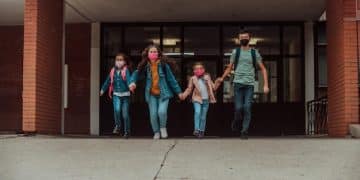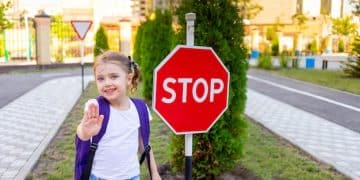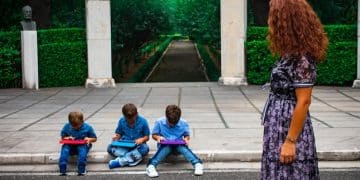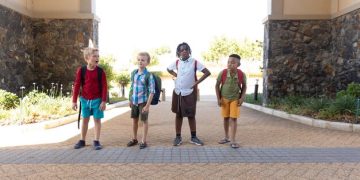The Role of School Resource Officers: Ensuring School Zone Safety
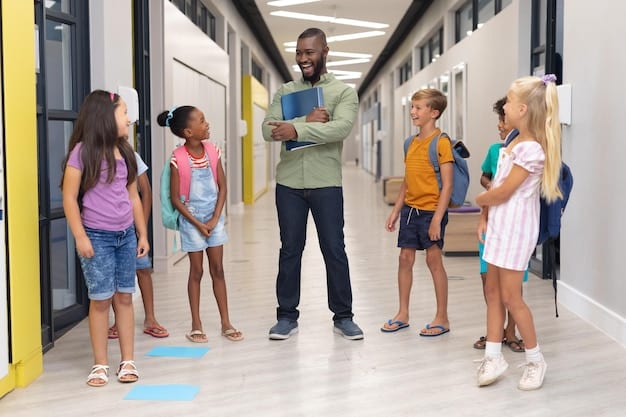
School Resource Officers (SROs) play a vital role in maintaining school zone safety by providing security, fostering positive relationships with students, and acting as a liaison between schools, law enforcement, and the community.
The safety and security of students, faculty, and staff within school zones are of paramount importance. The Role of School Resource Officers in Maintaining School Zone Safety is multifaceted, encompassing law enforcement, mentorship, and community relations. This article explores the vital contributions SROs make to create a secure and supportive learning environment.
Understanding the Vital Role of School Resource Officers
School Resource Officers (SROs) are more than just security personnel; they are integral members of the school community. Their presence helps bridge the gap between law enforcement and students, fostering trust and understanding. Let’s delve into the specific responsibilities and functions that SROs undertake to maintain safety within school zones.
What is a School Resource Officer?
A School Resource Officer is a sworn law enforcement officer assigned to a school or a district of schools. Unlike security guards, SROs have the authority to make arrests, conduct investigations, and carry firearms. Their primary goal is to ensure a safe and secure environment for students and staff.
The Dual Role: Law Enforcement and Education
SROs often serve a dual role, acting as both law enforcement officers and informal educators. They may conduct classroom presentations on topics such as drug awareness, internet safety, and bullying prevention. This proactive approach helps to educate students on important safety issues and build positive relationships.
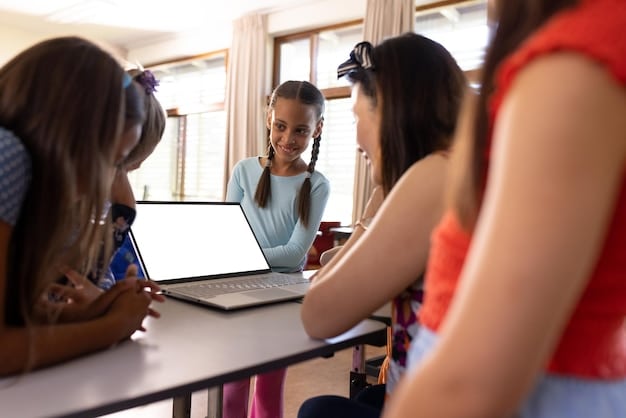
SROs also collaborate with school administrators and counselors to address behavioral issues and provide support to students in need. This collaborative approach ensures that students receive the appropriate resources and interventions to help them succeed.
- Providing a visible law enforcement presence to deter crime
- Responding to emergencies and providing assistance during crises
- Building positive relationships with students and staff
- Educating students on safety-related topics
In summary, School Resource Officers play a critical role in fostering a safe and secure school environment through law enforcement, education, and community engagement. Their multifaceted role significantly contributes to the well-being of students and staff.
Enhancing School Security Through SRO Presence
One of the most significant contributions of School Resource Officers is the enhancement of school security. Their consistent presence deters potential threats and provides a rapid response in emergency situations. Let’s explore how SROs bolster security measures within school zones.
Deterring Crime and Violence
The presence of an SRO can act as a significant deterrent to crime and violence. Knowing that a trained law enforcement officer is on-site can discourage individuals from engaging in illegal activities, such as bringing weapons or drugs onto school property.
Rapid Response to Emergencies
In the event of an emergency, such as a school shooting or a medical crisis, SROs are trained to respond quickly and effectively. Their presence can help to minimize the impact of such incidents and ensure the safety of students and staff.
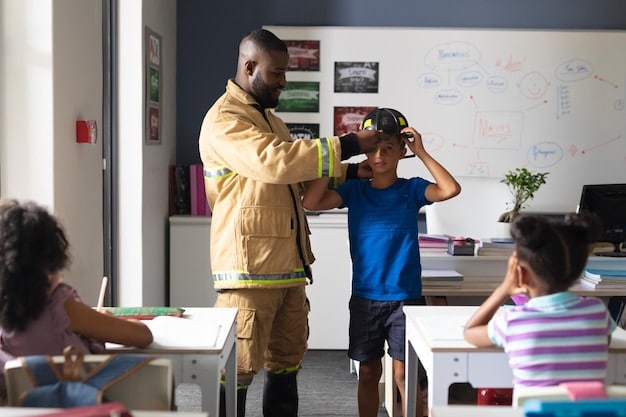
SROs also work closely with local law enforcement agencies to coordinate emergency response plans and conduct drills. This collaboration ensures that everyone is prepared and knows how to respond in the event of a crisis.
- Providing a visible security presence
- Conducting regular security assessments
- Collaborating with local law enforcement agencies
- Participating in emergency drills and training
Ultimately, the enhancement of school security through the presence of School Resource Officers is invaluable. Their proactive measures and rapid response capabilities create a safer environment for learning and growth.
Building Positive Relationships with Students
Beyond their law enforcement duties, School Resource Officers play a crucial role in building positive relationships with students. These relationships foster trust, improve communication, and create a more supportive school environment. Let’s examine how SROs connect with students on a personal level.
Mentorship and Guidance
Many SROs serve as mentors and role models for students, offering guidance and support. They can provide a listening ear, offer advice, and help students navigate challenges they may be facing at school or at home.
Creating a Safe and Supportive Environment
By building positive relationships with students, SROs contribute to creating a safe and supportive school environment. When students feel comfortable approaching an SRO, they are more likely to report incidents of bullying, harassment, or other safety concerns.
SROs often participate in school activities and events, such as sporting games, dances, and clubs. This involvement helps to humanize law enforcement and break down barriers between students and officers.
Furthermore, SROs may organize programs and initiatives to promote positive relationships, such as mentoring programs, conflict resolution workshops, and community service projects. These efforts contribute to building a more inclusive and supportive school community.
- Participating in school activities and events
- Offering mentorship and guidance to students
- Creating a safe and supportive environment
- Promoting positive relationships through programs and initiatives
In conclusion, building positive relationships with students is a cornerstone of the SRO’s role. These relationships enhance trust, improve communication, and foster a more supportive school environment.
Acting as a Liaison Between Schools and the Community
School Resource Officers serve as a vital link between schools, law enforcement, and the wider community. They facilitate communication, coordinate resources, and promote collaboration to address issues affecting student safety and well-being. Let’s explore how SROs bridge these important connections.
Facilitating Communication
SROs act as a point of contact for communication between schools, law enforcement, and community organizations. They can share information about potential threats, coordinate investigations, and provide updates on safety initiatives.
Coordinating Resources
SROs help to coordinate resources from various community organizations to support student needs. This can include connecting students with counseling services, mentoring programs, or other support services.
SROs also collaborate with parents and families to address concerns and provide guidance on safety-related issues. They may conduct home visits, participate in parent-teacher conferences, or offer educational workshops for parents.
Engaging with neighborhood associations, local businesses, and other community stakeholders is often coordinated by SROs. These partnerships can help to create a stronger sense of community ownership and support for school safety initiatives.
- Facilitating communication between schools, law enforcement, and the community
- Coordinating resources to support student needs
- Collaborating with parents and families
- Engaging with community stakeholders
In essence, serving as a liaison between schools and the community is a critical function of School Resource Officers. Their ability to connect stakeholders, coordinate resources, and facilitate communication strengthens the safety net surrounding students.
Addressing Concerns and Criticisms of SRO Programs
While School Resource Officers are widely recognized for their positive contributions, there are also concerns and criticisms surrounding SRO programs. These concerns often revolve around issues such as racial bias, over-policing, and the potential for negative interactions with students. Let’s examine some of these criticisms and explore possible mitigation strategies.
Racial Bias and Disparities in Discipline
One concern is the potential for racial bias in the enforcement of school discipline. Studies have shown that students of color may be disproportionately disciplined compared to their white peers. This can lead to a sense of unfairness and mistrust among students.
Over-Policing and Criminalization of Minor Offenses
Some critics argue that the presence of SROs can lead to over-policing and the criminalization of minor offenses. Behaviors that might have previously been handled as disciplinary matters within the school may now result in arrests or involvement with the juvenile justice system.
One common criticism revolves around inadequate training and preparation for SROs to work effectively with diverse student populations. If SROs are not properly trained in cultural sensitivity, conflict resolution, and de-escalation techniques, it can increase the likelihood of negative interactions.
To address these concerns, schools and law enforcement agencies can implement policies and training programs to promote equity, fairness, and understanding. This can include providing SROs with training on implicit bias, restorative justice practices, and trauma-informed approaches.
- Addressing racial bias and disparities in discipline
- Preventing over-policing and the criminalization of minor offenses
- Providing adequate training and preparation for SROs
- Implementing policies and practices that promote equity and fairness
In summary, addressing concerns and criticisms of SRO programs is essential to ensuring that they are implemented in a fair, equitable, and effective manner. By acknowledging and addressing these issues, schools and law enforcement agencies can work together to create a more positive and supportive learning environment for all students.
Best Practices for Effective SRO Programs
To maximize the effectiveness of School Resource Officer programs, it is essential to implement best practices that promote safety, equity, and positive relationships. These practices involve careful planning, ongoing training, and strong collaboration between schools and law enforcement agencies. Let’s explore some key best practices for effective SRO programs.
Developing Clear Roles and Responsibilities
One of the first steps in establishing an effective SRO program is to clearly define the roles and responsibilities of the SRO. This should include specifying the SRO’s duties related to law enforcement, security, education, and community relations.
Providing Comprehensive Training
SROs should receive comprehensive training that prepares them to work effectively with students, families, and school staff. This training should cover topics such as adolescent development, cultural sensitivity, conflict resolution, and de-escalation techniques.
It’s crucial to establish strong partnerships between schools, law enforcement agencies, and community organizations. Regular meetings, joint planning sessions, and shared decision-making processes can help to ensure that the SRO program is aligned with the needs and priorities of the school community.
Finally, develop data collection and evaluation systems to assess the effectiveness of the SRO program. This can involve tracking incidents of crime, violence, and disciplinary referrals, as well as gathering feedback from students, staff, and parents.
- Developing clear roles and responsibilities
- Providing comprehensive training
- Establishing strong partnerships
- Implementing data collection and evaluation systems
In conclusion, implementing best practices for School Resource Officer programs is critical to ensuring that they are effective in promoting safety, equity, and positive relationships. These practices can help to create a more supportive and secure learning environment for all students.
The Future of School Resource Officers and School Safety
As schools continue to grapple with issues such as violence, mental health, and social-emotional learning, the role of School Resource Officers is likely to evolve. The SRO must adapt to meet the changing needs of students and the community. Let’s consider the future of SROs and school safety.
Integration of Mental Health Support
One trend is the increasing integration of mental health support into SRO programs. This involves training SROs to recognize signs of mental health distress and connect students with appropriate resources.
Focus on Restorative Justice Practices
Another trend is the growing emphasis on restorative justice practices. This approach focuses on repairing harm, building relationships, and resolving conflicts in a way that promotes accountability and healing.
Technology such as social media monitoring tools and security cameras are used to enhance safety and security. If used thoughtfully, technology can provide information and enhance the work of SROs.
As always, focus on establishing stronger partnerships between schools, law enforcement agencies, and community organizations. These partnerships can help to create a more comprehensive and coordinated approach to school safety.
- Integration of mental health support
- Focus on restorative justice practices
- Leveraging technology to enhance safety and security
- Establishing stronger partnerships
In summary, the future of School Resource Officers and school safety is likely to involve a more holistic and collaborative approach that addresses the complex needs of students and the community. By embracing new strategies and technologies, SROs can continue to play a vital role in creating safe and supportive learning environments.
| Key Aspects | Brief Description |
|---|---|
| 👮 Law Enforcement | SROs maintain order and respond to emergencies, ensuring school safety. |
| 🤝 Community Liaison | They connect schools with law enforcement and community resources. |
| 📚 Education | SROs educate students on safety and legal topics. |
| 🌱 Mentorship | SROs offer guidance and build positive relationships with students. |
Frequently Asked Questions
▼
The primary role of a school resource officer is to provide a safe and secure learning environment for students and staff. It’s a mix of law enforcement, mentorship, and community relations within the school setting.
▼
SROs deter crime, respond to emergencies, and provide a visible security presence. They also collaborate with local law enforcement agencies and participate in emergency drills to enhance school safety.
▼
SROs typically receive specialized training in areas such as adolescent development, conflict resolution, cultural sensitivity, and de-escalation techniques. This helps them effectively interact with students and address their needs.
▼
SROs build relationships by participating in school events, offering mentorship, and creating a supportive environment. They aim to be approachable figures whom students can trust and seek guidance from.
▼
Criticisms often include concerns about racial bias, over-policing, and the potential for negative interactions with students. Addressing these concerns through training and policy changes is crucial for program effectiveness.
Conclusion
In conclusion, School Resource Officers play a pivotal role in maintaining school zone safety by combining law enforcement, mentorship, and community liaison responsibilities. While there are valid concerns and criticisms surrounding SRO programs, implementing best practices and focusing on positive relationships can help to maximize their effectiveness and create a safer, more supportive learning environment for all students.
